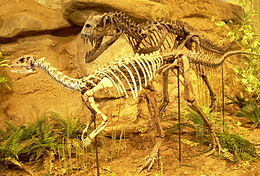- Dryosaurus
-
For the extinct crocodilian, see Dyrosaurus.
Dryosaurus
Temporal range: Late Jurassic, 155–145 Ma
D. altus skeleton (below) with Ceratosaurus Scientific classification 
Kingdom: Animalia Phylum: Chordata Class: Reptilia Superorder: Dinosauria Order: †Ornithischia Suborder: †Ornithopoda Family: †Dryosauridae Genus: †Dryosaurus
Marsh, 1894Species: †D. altus Binomial name Dryosaurus altus
(Marsh, 1878 [originally Laosaurus altus])Dryosaurus (
 /ˌdraɪ.ɵˈsɔrəs/ dry-o-sawr-əs; meaning 'oak lizard', Greek δρυο/dryo meaning 'oak' and σαυρος/sauros meaning 'lizard'; the name is from the vague oak shape of its cheek teeth) is a genus of an ornithopod dinosaur that lived in the Late Jurassic period. It was an iguanodont (formerly classified as a hypsilophodont). Fossils have been found in the western United States, and were first discovered in the late 19th century. Valdosaurus canaliculatus and Dysalotosaurus lettowvorbecki were both formerly considered to represent species of Dryosaurus.[1][2][3]
/ˌdraɪ.ɵˈsɔrəs/ dry-o-sawr-əs; meaning 'oak lizard', Greek δρυο/dryo meaning 'oak' and σαυρος/sauros meaning 'lizard'; the name is from the vague oak shape of its cheek teeth) is a genus of an ornithopod dinosaur that lived in the Late Jurassic period. It was an iguanodont (formerly classified as a hypsilophodont). Fossils have been found in the western United States, and were first discovered in the late 19th century. Valdosaurus canaliculatus and Dysalotosaurus lettowvorbecki were both formerly considered to represent species of Dryosaurus.[1][2][3]Contents
Paleobiology
Dryosaurus had a long neck, long, slender legs and a long, stiff tail. Its arms, however, with five fingers on each hand, were short. Known specimens were about 8 to 14 feet (2.4 to 4.3 m) long and weighed 170 to 200 pounds (77 to 91 kg). However, the adult size is unknown, as no known adult specimens of the genus have been found.[4]
Dryosaurus had a horny beak and cheek teeth and, like other ornithopods, was a herbivore. Some scientists suggest that it had cheek-like structures to prevent the loss of food while the animal processed it in the mouth.
A quick and agile runner with strong legs, Dryosaurus used its stiff tail as a counter-balance.[5] It probably relied on its speed as a main defense against carnivorous dinosaurs.
Diet and dentition
The teeth of Dryosaurus were, according to museum curator John Foster, characterized by "a strong median ridge on the lateral surface."[6]Dryosaurus subsisted primarily on low growing vegetation in the ancient floodplain.[6]
Growth and development
A Dryosaurus hatchling found at Dinosaur National Monument in Utah confirmed that Dryosaurus followed similar patterns of craniofacial development to other vertebrates; the eyes were proportionally large while young and the muzzle proportionally short.[6] As the animal grew, its eyes became proportionally smaller and its snout proportionally longer.[6]
Paleobiogeography and fossil distribution
Morrison Formation
In the Late Jurassic Morrison formation of Western North America, Dryosaurus remains have been recovered from stratigraphic zones 2-6.[7] A spectacular digsite near Uravan, Colorado held hundreds of D. altus fossils which represented multiple stages of the animal's life cycle. Other sites that have produced Dryosaurus material include Bone Cabin Quarry, the Red Fork of the Powder River in Wyoming and Lily Park in Colorado.[6]
See also
- List of dinosaurs
- Paleobiota of the Morrison Formation
Footnotes
- ^ Tom R. Hübner and Oliver W. M. Rauhut (2010). "A juvenile skull of Dysalotosaurus lettowvorbecki (Ornithischia: Iguanodontia), and implications for cranial ontogeny, phylogeny, and taxonomy in ornithopod dinosaurs". Zoological Journal of the Linnean Society 160 (2): 366–396. doi:10.1111/j.1096-3642.2010.00620.x.
- ^ McDonald AT, Kirkland JI, DeBlieux DD, Madsen SK, Cavin J, et al. (2010). "New Basal Iguanodonts from the Cedar Mountain Formation of Utah and the Evolution of Thumb-Spiked Dinosaurs". PLoS ONE 5 (11): e14075. doi:10.1371/journal.pone.0014075. http://www.plosone.org/article/info%3Adoi%2F10.1371%2Fjournal.pone.0014075.
- ^ Galton, P.M., 1977. "The Upper Jurassic dinosaur Dryosaurus and a Laurasia-Gondwana connection in the Upper Jurassic", Nature 268(5617): 230-232
- ^ Horner, John R.; de Ricqlés, Armand; Padian, Kevin; and Scheetz, Rodney D. (2009). "Comparative long bone histology and growth of the "hysilophodontid" dinosaurs Orodromeus makelai, Dryosaurus altus, and Tenontosaurus tillettii (Ornithischia: Euornithopoda)". Journal of Vertebrate Paleontology 29 (3): 734–747. doi:10.1671/039.029.0312.
- ^ Marshall (1999) pp. 138-139
- ^ a b c d e "Dryosaurus altus," Foster (2007) pp. 218-219.
- ^ "Appendix," Foster (2007) pp. 327-329.
References
- Foster, J. (2007). Jurassic West: The Dinosaurs of the Morrison Formation and Their World. Indiana University Press. 389pp.
- Palmer, D., ed (1999). The Marshall Illustrated Encyclopedia of Dinosaurs and Prehistoric Animals. London: Marshall Editions. pp. 138–139. ISBN 1-84028-152-9.
External links
Categories:- Dinosaurs of North America
- Dinosaurs of Africa
- Fossil taxa described in 1894
- Iguanodonts
- Jurassic dinosaurs
- Morrison fauna
Wikimedia Foundation. 2010.
